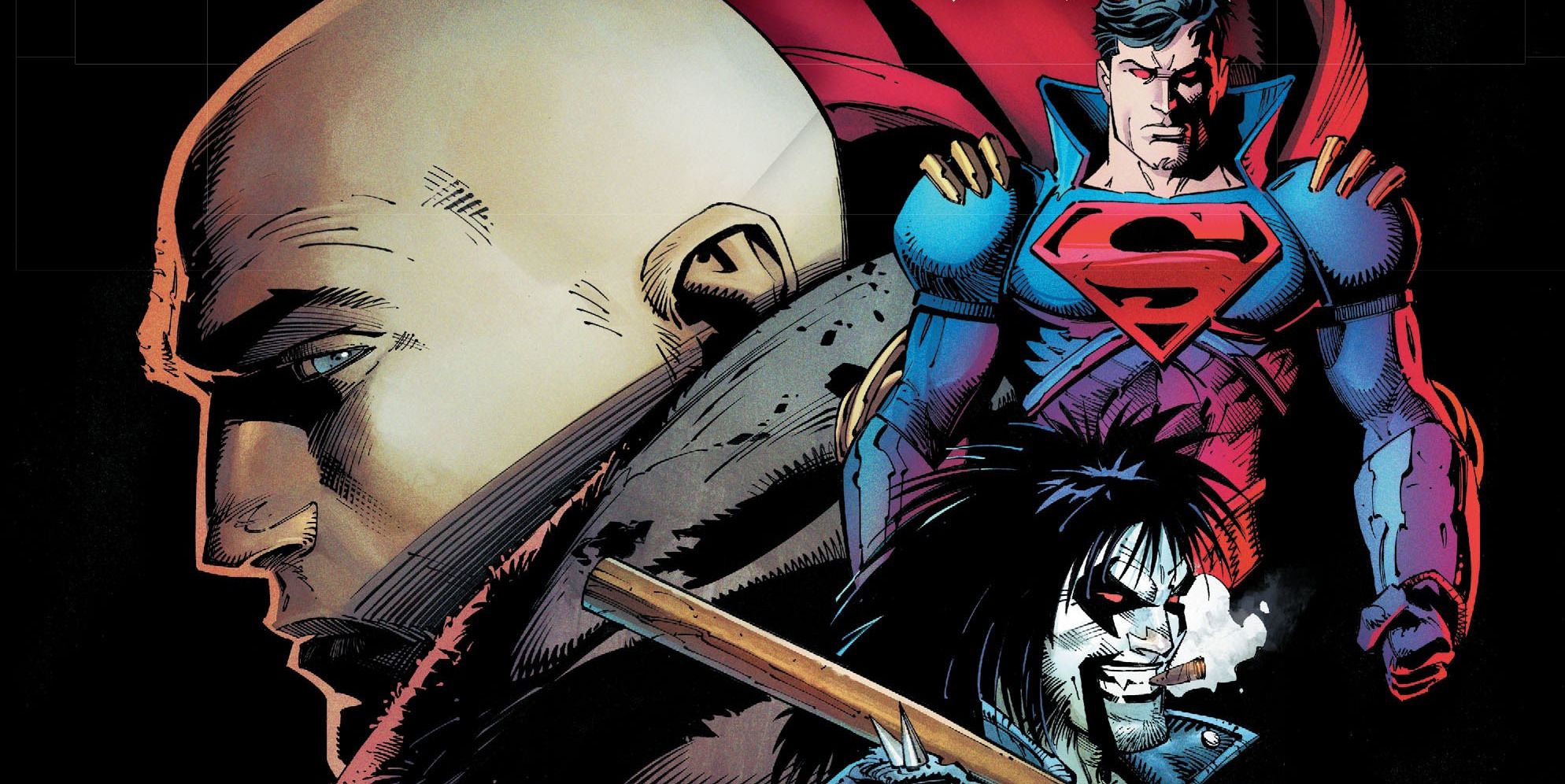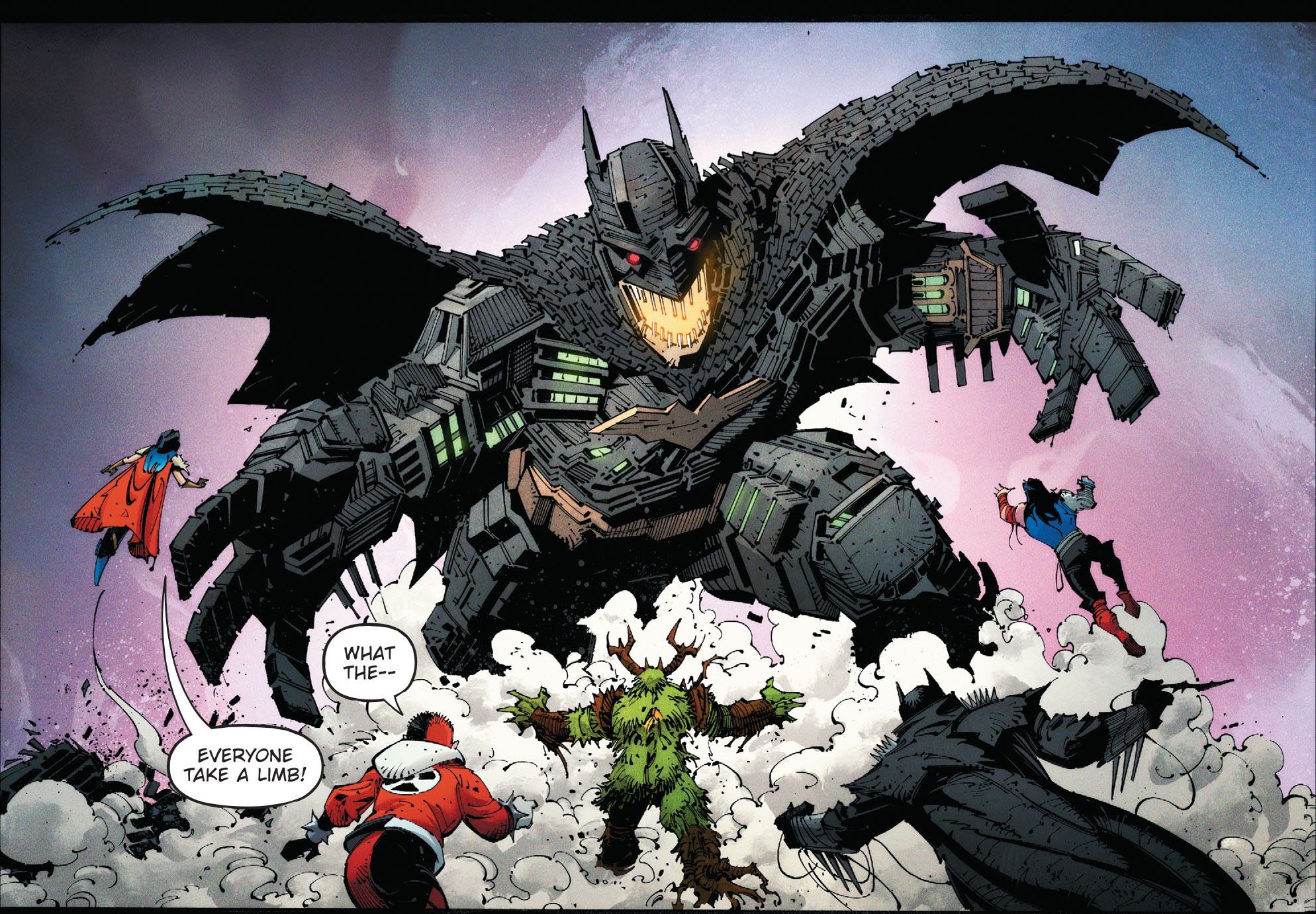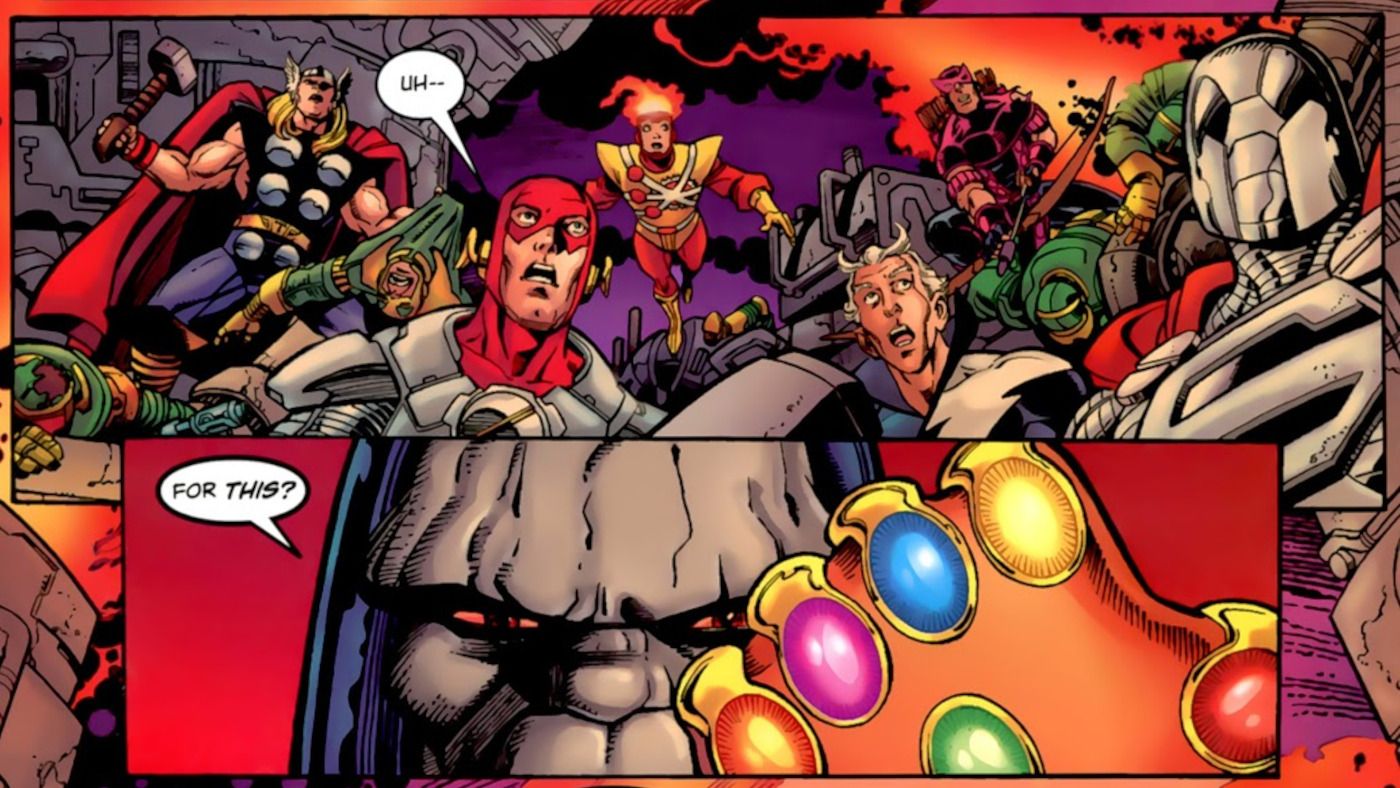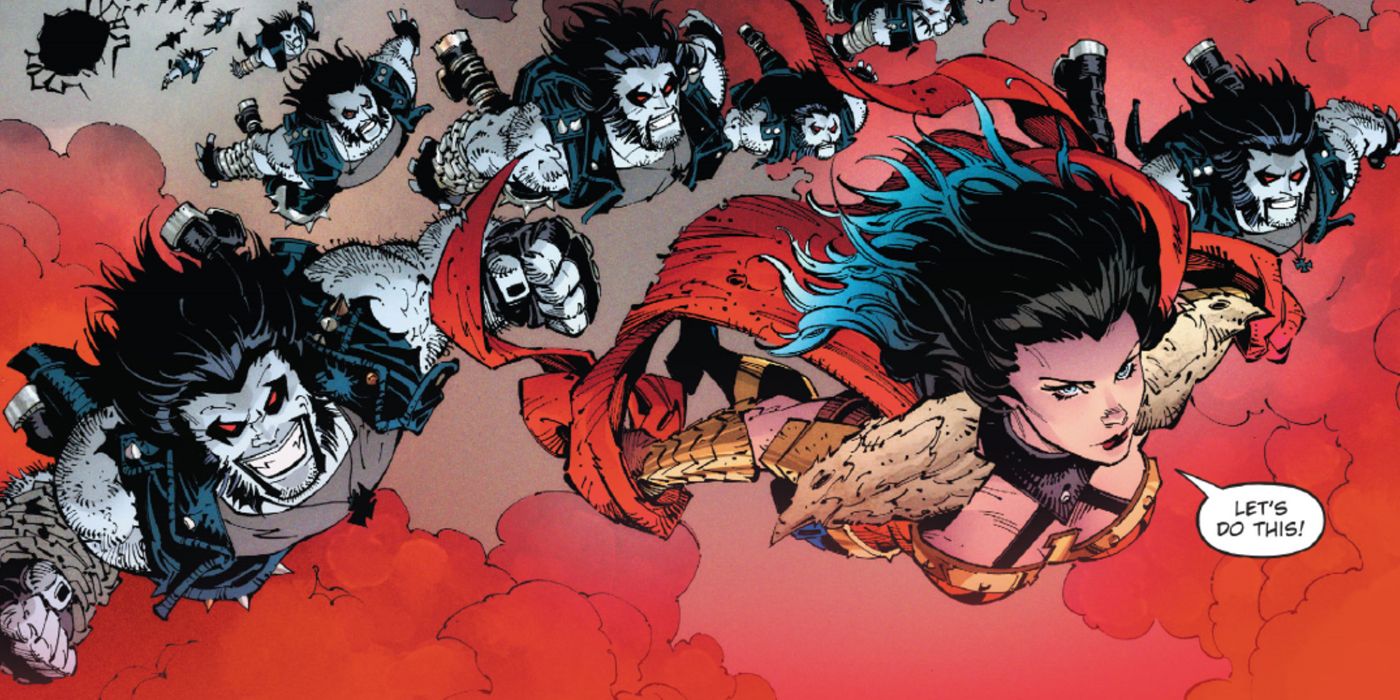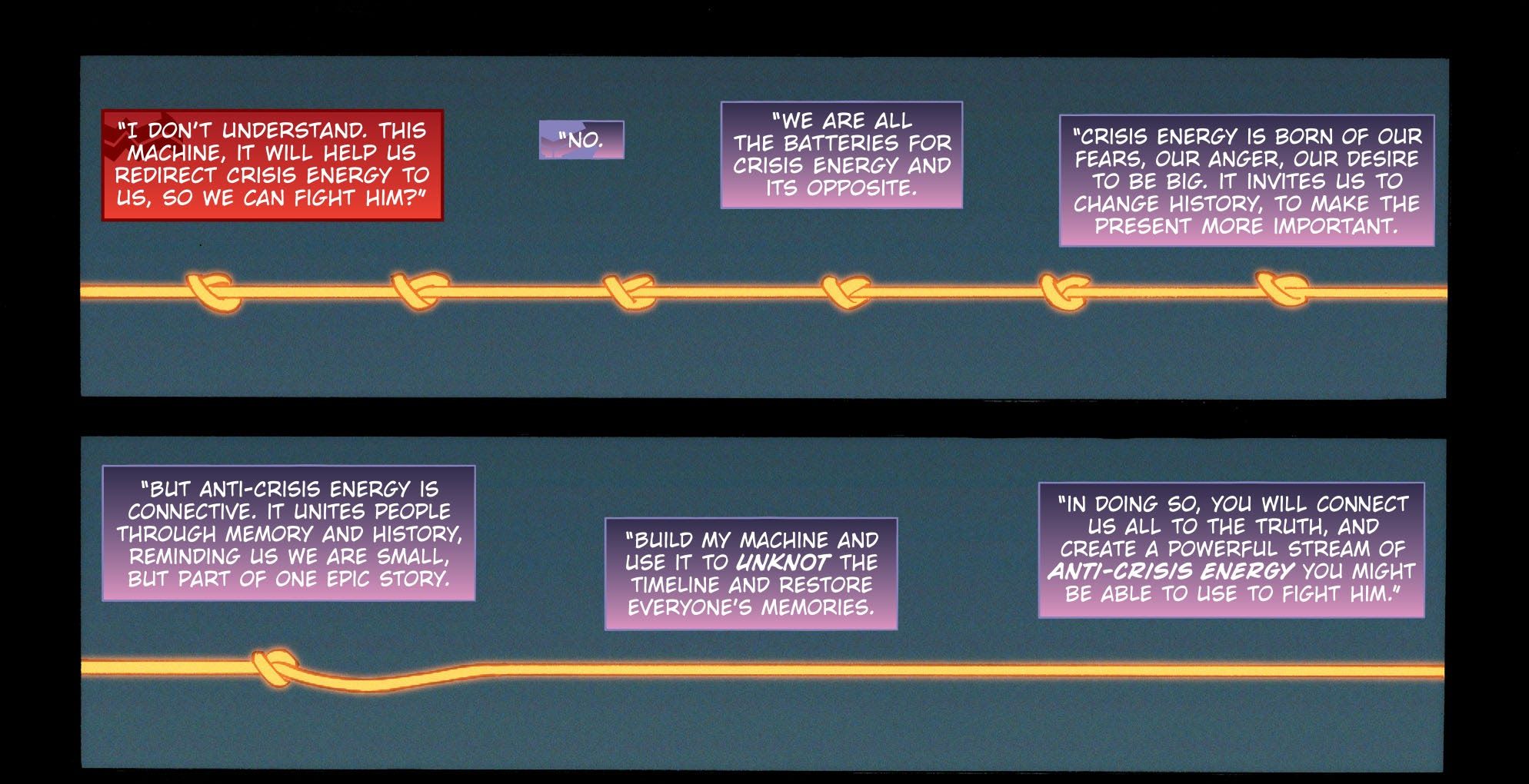WARNING: The following contains spoilers for Dark Nights: Death Metal #5, Death Metal: The Rise of the New God and Death Metal: Infinite Hour Exxxtreme! specials, and Justice League #56-57, all on sale now.
With the holidays fast approaching, we're thankful for a new issue of Dark Nights: Death Metal! It's been a busy month since Death Metal #4, so we'll be directing you through the pertinent tie-ins and, as always, pointing out the little things that might get lost among all the universe-shattering developments. Death Metal #5 weaves together developments from three tie-ins, namely the Rise of the New God and Infinite Hour Exxxtreme! specials and the Justice League arc that concludes with issue #57; and we'll dip into them as needed. Therefore, grab your copy of Death Metal #5, brace for spoilers and try to keep up!
Dark Nights: Death Metal #5 was written by Scott Snyder, penciled by Greg Capullo, inked by Jonathan Glapion, colored by FCO Plascencia, and lettered by Tom Napolitano. Jared Blando is credited as cartographer, while Darran Robinson designed the publication. The associate editor was Andrew Marino and the issue was edited by Marie Javins.
DC vs. Castle-Bat (Pages 1-5, 17)
Death Metal #4 ended with our heroes stunned at the revelation that they had unwittingly powered up the Batman Who Laughs. The next thing readers knew, the Batman Who Laughs was off to fight Perpetua in the Rise of the New God special. Apparently, he leaves for that battle on Page 2 of this issue. Considering the release order of the issues at hand, it's a little confusing, and you might have thought that on Page 2 he was returning from the ROTNG special, but that does not seem to be the case.
When the Robin King mentions Wonder Woman's oratorical skills (Page 1), it reminds us of when Diana eulogized Sue Dibny in August 2004's Identity Crisis #1. Then as now, readers didn't actually learn what was said but were just told how it was received. Green Arrow described the eulogy simply as "the kind of speech that's quoted in Bartlett's years from now."
On to the action at hand. We might not have realized it, but Castle Bat (Page 2) first appeared in Death Metal #1, hidden in plain sight as the Batman Who Laughs' headquarters. Writer Frank Tieri and artist Francesco Francavilla told its origin in October 2020's Dark Nights: Death Metal – Legends of the Dark Knights special. Specifically, in the near future, the adult Damian Wayne is Batman, the aging Bruce Wayne is retired and the rest of the Bat-Family is dead. Bruce then murders Damian as part of an occult ritual to cast his own soul into the city itself. That's basically it; the story was only 8 pages. Castle Bat's first appearance as a humanoid construct is on Page 3.
We could go down a deep rabbit hole on the topic of "Kane County" (Page 3) versus "Gotham County," so for now let's just stick to the surface. Both have been used to refer to the larger county in which Gotham City sits. Gotham County has its own law enforcement, namely the Gotham County Sheriff's Department, as seen in early issues of the 1993 Robin ongoing series. For example, when Steven "Shotgun" Smith" shows up in November 1993's Robin #1, he's a Gotham County Sheriff. That's also the first time we remember "Gotham County" getting any serious attention. However, it's a hard topic to research, because a lot of familiar Bat-locations -- including Wayne Manor and Arkham Asylum -- are located in the county, not the city. Therefore, searches for Gotham County or Kane County also tend to pick up false positives for those places. Anyway, the earliest reference we can find to "Kane County" is in February 2003's Gotham Central #2 (in particular, the Kane County Morgue). The "Gotham City" entry from 2008's Essential Batman Encyclopedia tries to harmonize the two names by stating that "Gotham County" is a nickname for Kane County, "given the disproportionate size of the city to the county boundaries." That might seem like a lot, but it's the short version.
Page 3 appears to show Superman shooting Omega Beams, Darkseid-style, presumably due to his anti-life affliction. Superman's vulnerability to red-sun radiation (Page 4) goes at least as far back as October 1963's Superman #164.
The Rot (Page 3), also known as The Black, is a primal force which acts in opposition to more benevolent forces like The Green (which empowers Swamp Thing and other Earth elementals) and The Red (which does the same for animal-based heroes like Animal Man and Vixen). The Rot was first mentioned in November 2011's Animal Man #1, written by Jeff Lemire and drawn by Travel Forman. The current avatar of the Rot is Abigail "Abby" Arcane (Page 17), created by Len Wein and Berni Wrightson for March 1973's Swamp Thing #3. She became the Rot's avatar in May 2013's Swamp Thing #18, written by Scott Snyder and drawn by Yanick Paquette.
The nearly-indestructible material Inertron (Page 4) first appeared in September 1965's Adventure Comics #336, in a Legion of Super-Heroes story written by Edmond Hamilton, pencilled by John Forte and inked by Sheldon Moldoff. For many years it was only part of Legion lore, but clearly, it has made its way to the present-day DC Universe. October 2010's DC Universe: Legacies #4 established that it was part of a deathtrap for the about-to-be-revived Justice Society, and more recently it was mentioned in several issues of the Christopher Priest-written Deathstroke (from November 2017's issue #23 to February 2020's issue #50.)
We're not finding a whole lot on "entropic gems," but we can't help but be reminded of another publisher's uniquely bedazzled hand covering. Darkseid donned the Infinity Gauntlet in December 2003's Avengers/JLA #2 and discovered to his irritation that the Infinity Gems were useless in the DC Universe.
Gardner Fox and Bob Kane created the Mad Monk (Page 5) for September 1939's Detective Comics #31. Originally known simply as the Monk, he was a vampire (also described as a werewolf) who lured Bruce Wayne's girlfriend to Hungary for nefarious purposes. Arguably, the Monk is Batman's first costumed supervillain; but today. the Monk two-parter may be most famous for introducing early versions of the Batplane and especially the Batarang. In Detective #32's concluding chapter, Batman shoots the Monk and his lackey with silver bullets, killing them. The Monk storyline was revisited a couple of times, first in July-September 1982 (Batman #349 to Detective Comics #518) and then in Matt Wagner's Batman and the Mad Monk miniseries (October 2006-March 2007). From what we can tell, Wagner dubbed the villain "the Mad Monk."
Hephaestus (Page 5) is the Greek god of the forge. The DC version of Hephaestus first appeared in November 1976's Wonder Woman #226. He got makeovers as Wonder Woman was revamped in March 1987's Wonder Woman #2 and May 2012's Wonder Woman #7.
Bill Willingham and Justiniano created the Oblivion Bar (Page 5), mystical extradimensional taproom and headquarters of Shadowpact, for June 2005's Day Of Vengeance #1. The Night Sword, or the Sword of Night, belonged to Jim "Nightmaster" Rook, who was created by Denny O'Neil and Jerry Grandinetti and first appeared in May 1969's Showcase #82. The sword could warn its wielder of danger and force people to speak the truth. The Dark Knights killed Nightmaster in the Oblivion Bar in December 2017's Dark Nights: Metal #3.
Lex Luthor Begins (Pages 6, 8-9, 11)
The Hall of Doom arrives on Page 6 direct from January 2021's Justice League #57, which is best read before digging into Death Metal #5. Nightwing, Hawkgirl, Detective Chimp, Martian Manhunter, Starfire and Cyborg helped Luthor free Sinestro, Grodd and Cheetah from Perpetua's throne in Early January 2021's Justice League #56. In issue #57, on sale now, Luthor tells Grodd that they "will show the world they were right to side with doom." He goes on to say he has "plans" – most likely involving Lobo's retrieval of the 10th Metal – which "can help us get what we want without the Justice League's help."
Of course, those who watched the CW's Arrowverse version of Crisis On Infinite Earths will remember how Lex hijacked the heroes' plan for his own purposes, using the Book of Destiny to rewrite history in his favor. We can't help thinking that Lex may have the tiniest of ulterior motives in encouraging the building of his machine. Still, on Page 15, when Wonder Woman encourages Luthor to "be the hero," that reminded us of 2013's Forever Evil, when Lex did indeed help save Earth-0. For that matter, Luthor calling Wonder Woman "Diana" on Page 11 calls to mind his brief stint serving alongside her in the Justice League.
On Page 8, Luthor warns that the Batman Who Laughs wants to "surround this empty Earth ... with his own versions." This is at least superficially similar to the plan Earth-Three's Alex Luthor hatched in Infinite Crisis. There, as on Page 22 of this issue, the main DC Earth was surrounded by scads of parallel Earths; although those were probably a lot more benign.
Page 9 is all about Lex Luthor's Smallville childhood, a part of his backstory first seen in April 1960's Adventure Comics #271. This is the classic story of Lex and Superboy's doomed friendship, as told by writer Jerry Siegel and artist Al Plastino. After Lex saves Superboy from a chunk of Kryptonite, the Boy of Steel repays him by building him a state-of-the-art laboratory. Luthor actually succeeds in creating a protoplasmic life-form (!!!) in what looks like a well-stocked mobile home. However, in the course of making a Kryptonite antidote, Lex knocks over some test tubes and the lab bursts into flames. Although Superboy saves Lex, the new life-form is destroyed and Lex is rendered permanently bald. He swears eternal revenge – to be clear, for the loss of his new creation, not the loss of his hair – and a supervillain career is born.
The 1986 Superman reboot excised both Luthor's Smallville period and Superman's Superboy career, so their first meeting was in Metropolis as adults. This lasted until the Superman: Birthright miniseries (September 2003-September 2004) revision of Superman's origins, which revealed that young Lex had indeed spent time in Smallville with a teenaged Clark Kent. No doubt this particular revision was intended to capitalize on the success of the Smallville TV series (2001-10), which had a Lex/Clark bromance at its heart.
Lex's father Lionel was also a big part of the Smallville show, although in the comics the elder Luthor was originally named Jules. Created by Jerry Siegel and Kurt Schaffenberger for February 1961's Lois Lane #23, Jules kicked Lex out of the house as punishment for his turn to the dark side. Jules then changed the family name to Thorul so Lex wouldn't be able to find them. Lex did find them, of course; but left them alone so that they could live in peace. Lionel himself first appeared in flashback in March 2017's Superwoman #6 (by Phil Jimenez and Jack Herbert), and readers learned his tragic fate in August 2018's Justice League #1. The short version is, he was involved in all this Perpetua stuff, it overwhelmed him, he took it out on Lex, and Lex probably had him killed.
To The Exxxtreme! (Pages 10, 13, 15)
Page 10 provides a look at Luthor's notebook, where he has sketched the Mobius Chair, the Hand of Creation, an adult human skeleton looking over two child-sized human skeletons, the Daily Planet building, and what looks like a version of the Miracle Machine. Our best guesses for the skeleton family are either the Luthors themselves (Lex, sister Lena, and their dad) or Perpetua, the Monitor and the Anti-Monitor.
Back in the annotations for Metal #2, we noted that the Daily Planet globe may be made of metal from the sinister Judas Tribe. Since the globe is part of Luthor's notebook sketches, he might want to use it for some sort of broadcast or attractor. The globe made its first appearance in a Fleischer Studios Superman cartoon, "The Arctic Circle," which premiered on February 26, 1942. The Planet building in the comics sported a globe on the roof starting in November 1942's Superman #19, and November 1943's Superman #25 put a ring (of letters spelling out the name) on it. We're not sure when the "Daily Planet" name started resting on a Saturn-style ring, but it was there by June 1957's Action Comics #229.
We'd be a little disappointed if Death Metal's resolution depended on the Miracle Machine, because it was a big part of Final Crisis' climax. The Miracle Machine is an all-purpose get-out-of-jail-free device, created by the Guardians of the Universe and given to the Legion of Super-Heroes after they stopped a rogue Controller, a relative/rival of the Guardians of the Universe. It first appeared in April 1968's Adventure Comics #367, in a story written by Jim Shooter and penciled by Shooter and Curt Swan. The gizmo Luthor has sketched here doesn't look exactly the same, but it's close.
The World Forge, or Forge of Worlds (Page 10), first appeared in February 2018's Dark Nights: Metal #4.
Lobo retrieved the Tenth Metal,or Metal X (Page 10) in the Infinite Hour Exxxtreme special. There, Luthor called it the "Death Metal."
The Main Man isn't kidding about his "unique regenerative abilities" (Pages 10 and 13). According to October 1988's Justice League International #18, one drop of Lobo's blood is enough to regenerate into another Lobo. Thus, we have Page 15's army of Lobos. The sight of them skydiving alongside Wonder Woman made us think immediately of a similarly-staged scene from July 2006's Nextwave #5, wherein Dirk Anger unleashes a batch of cuddly teddy bear death from above.
The Last Crisis You'll Ever Need (Pages 11, 13)
On Page 11, Luthor notes that while Crisis energy "make[s] the present more important," Anti-Crisis energy "remind[s] us we are small, but part of one epic story." Naturally, this comes across as another metatextual dig at the short-term and long-term tradeoffs for rebooting and/or relaunching one's shared superhero universe. Of course, for those of us who have been emotionally invested in DC Comics since the Ford Administration, these sorts of events tend to be some combination of satisfying (in that their deep cuts affirm our lifelong fandom) and frustrating (because often, they ask us to accept new versions of those familiar elements). Death Metal bills itself as an "Anti-Crisis," so a significant part of its metatext involves explaining how it intends to undo all those cosmic reorganizations.
Accordingly, Wonder Woman's dialogue on Page 13 not only calls back to previous DC events, it reinforces why those approaches can't work anymore. 1994's Zero Hour involved Hal "Parallax" Jordan trying to "restart everything [his] way," while the Rebirth relaunches were, at least in part, about go back to the past. It's not enough to bring in a new approach to continuity, Death Metal argues – you have to cast the widest possible net, and acknowledge everything. To be sure, that might result in a tweaked timeline for the main DC Universe – which would by definition involve another new approach to continuity – but it almost certainly means placing the primary DC Earth within an infinite, Silver Age-style Multiverse.
While there are lots of DC readers who couldn't give two cosmic hoots about the layout of the Multiverse, that's the great irony of these events: They're supposed to get readers excited about DC generally so that the existing fans have a reason to keep reading while giving hypothetical new fans can jump aboard more easily. Ideally, they make DC's superhero books more accessible. However, if you're not invested in the process, you may not have an incentive to read the series which lays it all out. Therefore, the true test of Death Metal's effectiveness may well be the extent to which DC's readership increases after it's over. Death Metal seems to be setting itself up as the last big cosmic event for a long while – maybe ever – and we're curious to see how long that lasts.
Come back tomorrow for much more, including more thoughts on where Death Metal has been and where it might go!
0 Links

